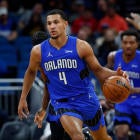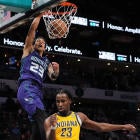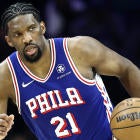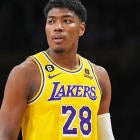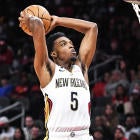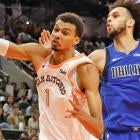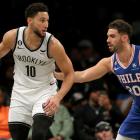Small forward can be a source of consternation for many a Fantasy owner, regardless of format. With respect to production, it can be a rather fickle position.
As we'll dive into below, there's a significant drop-off between the top few tiers, which are loaded with some of the elite players in the NBA, and a middle-to-late-round crop that's replete with hit-or-miss types.
The top two at the position, LeBron James and Kevin Durant, command their own level, while Paul George and Kawhi Leonard, already having achieved elite status themselves, are just a notch below.
Considering the uncertainty regarding many small forwards after a certain point, there is a sizable selection of Tier IV and Tier V options.
Tier I: Elite of the Elite
LeBron James, Kevin Durant, Giannis Antetokounmpo
James posted the best numbers of his second stint in Cleveland last season, including career highs in rebounds (8.6) and assists (8.7). Although he took a handful of games off to rest, James played nearly 38 minutes per game and demonstrated few signs of wear and tear. Despite rumors about his future and the belief that he has to decline at some point, there's no reason to consider James anything but an elite option. In fact, given his 34.3 percent usage rate without Irving on the court last season, the potential absence of Irving could result in even more offensive responsibility.
Durant was every bit the perfect fit Golden State imagined he'd be, and to the satisfaction of Fantasy owners, his numbers didn't appreciably suffer, despite sharing the court with three superstars. In fact, Durant posted career-highs in rebounds (8.9), assists (5.2), blocks (1.7), and his shooting percentage jumped to nearly 54 percent. Heading into Year 2 of his second act, Durant could be an even more effective Fantasy commodity if he's able to avoid missed time due to injury.
Tier IA: Just a Step Below
Paul George, Kawhi Leonard
George lands in an interesting situation in Oklahoma City, and despite the presence of Russell Westbrook, he'll play a major offensive role. After a slow start, George ramped up his production last season, tallying career-bests in scoring (23.7) and shooting efficiency (46.7 percent). Rather than serving as a drain on his production, Westbrook should open things up for George. There may be some growing pains, but George has never played alongside anyone near Westbrook's talent level.
Leonard is expected back at full health for training camp after his ankle injury derailed the Spurs' postseason. There's no reason to think he won't build on his career-best scoring average from last season, especially after San Antonio failed to make significant offseason upgrades, outside of adding Rudy Gay, who's coming off of a torn Achilles.
Tier II: Productive Stars
Carmelo Anthony, Gordon Hayward, Andrew Wiggins
Anthony's reputation has certainly taken a hit in recent years, but he's still producing at a high level. And so long as he's in New York, he'll be the No. 1 option. The concern for Fantasy owners is that Anthony could be moved to a less-favorable situation.
Hayward enters a new situation in Boston, but he'll play for a familiar face in Brad Stevens, which should ease the adjustment process. Production-wise, don't expect too much of a drop-off, though playing alongside a high-usage point guard in Isaiah Thomas could take the ball out of Hayward's hands a bit more often.
Wiggins broke out with a career-best 23.6 points per game last season, due in large part to improved 3-point shooting. The addition of Jimmy Butler will sap some of Wiggins' usage, but it should also mean fewer double-teams and end-of-shot clock isos.
Tier III: Above-Average Starters
Harrison Barnes, Tobias Harris, Michael Kidd-Gilchrist, Trevor Ariza, Danilo Gallinari, Wilson Chandler, Khris Middleton, Brandon Ingram, Otto Porter, Ben Simmons, Robert Covington
After coming over from Golden State, Barnes made an expected leap in production, but he handed out fewer than two assists per game and doesn't provide elite defensive numbers.
Ariza's scoring has declined in four straight seasons, but he's made up for it with steady two-way production -- 5.7 rebounds, 2.2 assists, 1.8 steals, 2.4 3-pointers made per game -- for a role player.
Middleton missed the first two-thirds of the season but didn't miss a beat when he returned in mid-February. An ideal two-way complement to Giannis Antetokounmpo, Middleton isn't a go-to scorer, but he's a steady secondary playmaker (3.4 assists per game) who rebounds his position and knocks down threes at around a 40 percent clip.
After an up-and-down rookie season, expectations are high for Ingram in Year 2. Lonzo Ball will be the engine that drives the Lakers' offense, but Ingram may be the best pure scorer on an improved roster overall.
Simmons earns Tier III designation on upside and potential alone. He should be an excellent fit on an offense brimming with young talent now that he's fully recovered from the foot injury that robbed him of what would have been his true rookie year.
Consistent production and increased minutes over the last three seasons make Covington worthy of a look. While his role is somewhat unclear given the arrival of Simmons, Covington will be a key piece off the bench, at worst.
Tier IV: Steady Veterans and Young Unknowns
Josh Jackson, Rudy Gay, Taurean Prince, Allen Crabbe, T.J. Warren, Lance Stephenson, Chandler Parsons, Justise Winslow, Solomon Hill, Evan Turner, Paul Zipser, Terrence Ross, C.J. Miles, Joe Johnson, Marcus Morris, Bojan Bogdanovic, Jayson Tatum,
This tier features a mixture of first-time projected starters -- Prince, Zipser, Crabbe -- solid veterans of varying upside -- Turner, Johnson, Ross, Miles, Hill -- likely bench players with scoring potential -- Bogdanovic, Morris -- and flat-out question marks (Parsons, Stephenson).
Meanwhile, Winslow could take a step forward if he's completely over his shoulder injury, while Warren and Jackson may end up hurting each other's value in Phoenix. Jackson could very well play his way into Tier III value, but his jump shot is still too much of an unknown at this point. At the very least, though, he should rebound at a high rate and rack up quality defensive numbers for a rookie.
Tatum may be just as talented as Jackson, but his projected role will simply be too small to warrant more than late-round or waiver consideration in Year 1. At the moment, the No. 3 overall pick is much more valuable in dynasty than season-long formats.
Tier V: Late-Round Fliers
Juancho Hernangomez, DeMarre Carroll, Maurice Harkless, Al-Farouq Aminu, Glenn Robinson III, Garrett Temple, Justin Anderson, Kelly Oubre, Justin Jackson
Tier V houses an interesting mix of young talent and proven veterans, though most are best avoided until the later rounds. Carroll has been a shell of himself since leaving the Hawks, while promising young players like Hernangomez, Oubre, and Jackson will struggle to see enough minutes to achieve Fantasy relevance.
The wild card may be Robinson, who will have a chance to step into a larger role for the Pacers, who moved on from Paul George, C.J. Miles and Monta Ellis over the summer.













